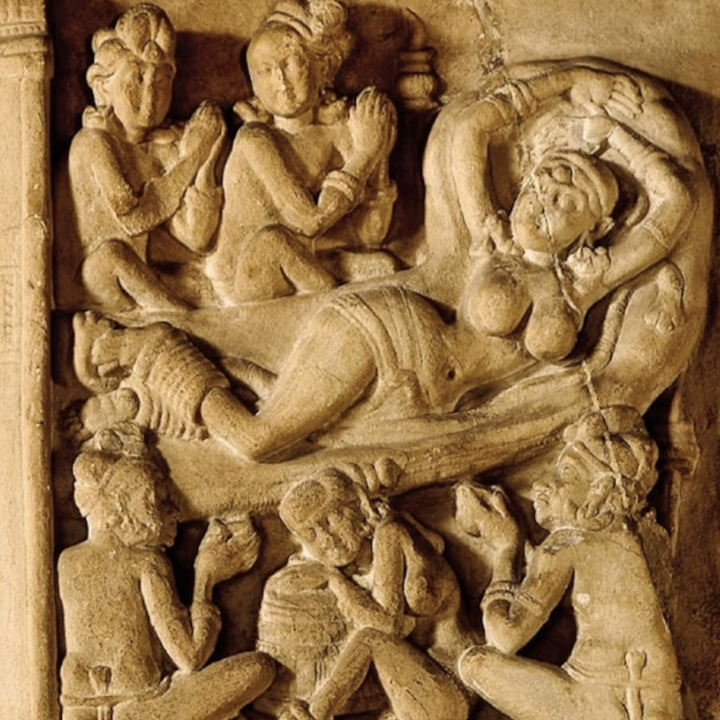Before Comics: the Great Stupa at Amaravati
The Great Stupa at Amaravati is a Buddhist temple in India built between the third century BCE and 250 CE. The construction time period is so long because the stupa was added onto and revised several times. Even though it is in ruins, The Stupa at Amaravati is still one of the most highly decorated buddhist temples in India.
We know that the stupa was continually added onto due to archaeological research, but also due to the images in the stupa itself. There are several reliefs depicting the stupa at various points throughout history, making the images into a (probably unintentional) sequential narrative.

Yet the stupa contains intentional sequential narratives. The most discussed piece is a relief panel depicting the Buddha’s birth.

The artwork is divided into four panels, reading right to left from top to bottom. The panel borders are pillars and brickwork. I want to call attention to this decorative decision, because in most sequential art these days, panel borders are meant to be unobtrusive, simple lines that delineate space but not interfere with the drawing in the panel itself. Contemporary artists play more with the shape of a panel than the form of its border. So while this piece of sequential art may be centuries old, the artist (or artists) who created it was making decisions that many contemporary artists don’t even consider. Yet it makes sense that approaching sequential art through relief carving would lead to more a decorative approach.


Panel one depicts Buddha’s mother, Maya, as she dreams (Walker is my source for the story). Supposedly, she is dreaming that she was pierced in her side by a white elephant. You can see the attendants around her. If you look at the heads of the two in the top left of the panel, you will see that the same are also in the top left of the second panel. Yet in this panel, their fingers are pointed up, in explanation. That is because in panel two, the sages are recounting Maya’s dream to her husband, Suddhodana. Also, the horizontal form of Maya in the first panel points towards her husband in the second (look at the full image near the top to see the flow, the order is reversed in the gallery directly above).


Panel three, in the bottom right, depicts the birth itself. The Buddha emerges from the same spot where Maya dreamed that the white elephant pierced her. I love how calm Maya looks here, even though she’s giving birth. You can see her attendants holding a cloth. This looks to be the same cloth that is being presented in the fourth panel. Notice how the line of the cloth in the third panel matches with the horizontal decorations of the panel border (again, refer to the full image near the top), which helps to move the action from the third panel into the fourth.
In contrast to the art we have seen so far (see: Before Comics), the figures in this piece are not all in profile. Many are in three-quarter view. So we have fuller and more complete depictions of the human figure.
According to Nathan Kondala, there are other pieces from the site that contain sequential art. The only source I have for these is Kondala’s site itself and the images are very small. So I am not going to comment on them much.

One that Kondala mentions is the Mandhata Jataka which depicts the story of Mandhata, a perfect ruler. Kondala describes the piece: “Bordered square panels, three below, three above this central scene, depict different stages of his rise and fall.” I am curious whether his “rise” is depicted on the top and his “fall” on the bottom. If so, this would mean the artist was using physical space to create metaphorical meaning.

Another is the Shaddanta Jakata, which depicts seven scenes of the six-tusked elephant, Shaddanta. As Kondala says, “There are no artificial divisions here, the scenes meld into each other seamlessly.” So in a small space we have an entire story with only the repeated image on the elephant to let the viewer know that this is a set of scenes and not a single image.
So the Great Stupa at Amaravati is not simply an amazing artistic and historical site, it is also very rich for those of us looking at the history of sequential art.
Sources:
Main ones about sequential art:
Kondola, Nathan. “Amaravati Sculpture: Immortalized in Stone.” Just History: https://upsc4history.wordpress.com/2018/09/14/amaravati-sculpture-immortalised-in-stone/
Walker, Veronica. “Lumbini: Birthplace of the Buddha.” National Geographic: History, September/October 2020.
Additional information about the site:
British Museum:
https://www.britishmuseum.org/collection/galleries/india-amaravati


